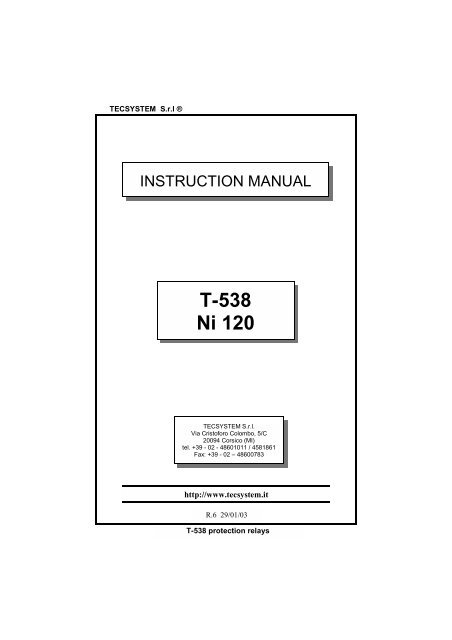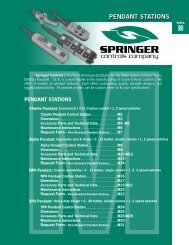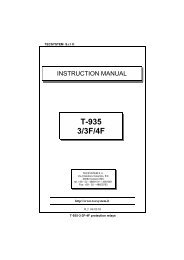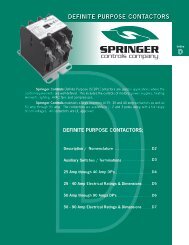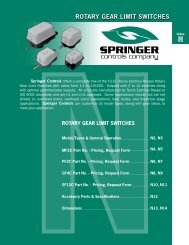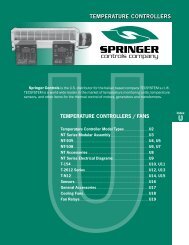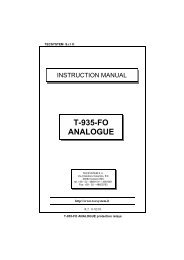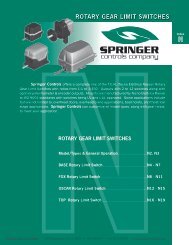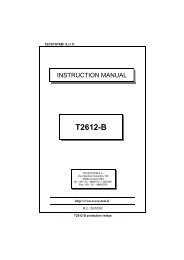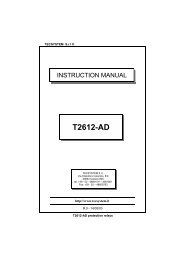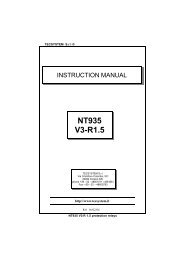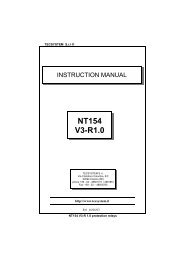T538Ni120 Instruction Manual
T538Ni120 Instruction Manual
T538Ni120 Instruction Manual
Create successful ePaper yourself
Turn your PDF publications into a flip-book with our unique Google optimized e-Paper software.
TECSYSTEM S.r.l ®<br />
INSTRUCTION MANUAL<br />
T-538<br />
Ni 120<br />
TECSYSTEM S.r.l.<br />
Via Cristoforo Colombo, 5/C<br />
20094 Corsico (MI)<br />
tel. +39 - 02 - 48601011 / 4581861<br />
Fax: +39 - 02 – 48600783<br />
http://www.tecsystem.it<br />
R.6 29/01/03<br />
T-538 protection relays
TECSYSTEM S.r.l ®<br />
2 T-538 protection relays
TECSYSTEM S.r.l ®<br />
1) TECHNICAL SPECIFICATIONS<br />
AUXILIARY POWER SUPPLY<br />
• Rated voltage 24-240 Vac-dc<br />
• Maximum ratings 20.270 Vac-dc<br />
• Vdc with reversible polarities<br />
COMMUNICATION<br />
• Opt. Output RS232/485 Modbus® RTU<br />
INPUTS<br />
• 8 inputs RTD Ni 120 sensors-3 wires<br />
• removable rear terminals<br />
• input channels protected against electromagnetic<br />
noises and spikes<br />
• sensors lenght cables compensation<br />
up to 500 m (1mm²)<br />
• opt. 8 analog inputs 4-20mA (range 0-<br />
240°C)<br />
TESTS AND PERFORMANCES<br />
• Assembling in accordance with CE rules<br />
• Protection against electrical and magnetic<br />
noises: CEI-EN50081-2/50082-<br />
2<br />
• Dielectric strength 2500 Vac for 1 min.<br />
from relays to sensors, relays to power<br />
supply, power supply to sensors<br />
• Accuracy: ± 1% full scale, ± 1 digit<br />
• Ambient operating temperature –20°C<br />
to +60°C<br />
• Humidity 90% no-condensing<br />
• ABS self-extinguishing housing<br />
NORYL 94VO<br />
• Burden 3Va<br />
• Data storage 10 years minimum<br />
• Digital linearity of sensors signal<br />
• Self-diagnostic circuit<br />
• Opt. Protection treatement of electronic<br />
part<br />
DIMENSIONS<br />
• 96x96mm-DIN43700-Prof.150mm<br />
(with rear terminals)<br />
• panel cutout 92x92mm<br />
OUTPUTS<br />
• 2 alarm relays (ALARM-TRIP)<br />
• 1 alarm relay for sensor fault or working<br />
anomaly (FAULT)<br />
• output contacts capacity: 5A-250Vac<br />
res.<br />
• Arranged for output relays test<br />
• ALARM&TRIP programming for Fail Safe<br />
and NO Fail safe<br />
• Opt. Relay AUX.1 (FAN)<br />
DISPLAYING AND DATA MANAGEMENT<br />
• 1display 13mm high 3 digit with 3 digit<br />
for displaying temeratures<br />
• 8 LED for displaying reference channel<br />
• 8 LED indicating alarm or trip<br />
• LED indicating fault<br />
• Temperature monitoring from 0°C to<br />
240°C<br />
• 2 alarm thresholds for each input<br />
• sensors diagnostic (Fcc-Foc-Fcd)<br />
• entering the programming by frontal<br />
push button<br />
• automatic output from programming<br />
cycle after 1 min. of no-operation<br />
• wrong programming automatic display<br />
• programmed data call out<br />
• possibility of setting manual channel<br />
scanning or hottest channel<br />
• maximum temperatures storage<br />
• number of channels software programmable<br />
from 1 to 8<br />
T-538 protection relays<br />
3
TECSYSTEM S.r.l ®<br />
2) MOUNTING<br />
Make a hole with the dimensions of 92x92 mm in the panel plate.<br />
Fasten firmly the unit by the fixing blocks you are equiped with.<br />
3) POWER SUPPLY<br />
The T-538 unit has an Universal Power Supply: it can be supplied indifferently from 24 to<br />
240 Vac-dc without any respect of the polarities.<br />
This particularity is obtained by the application of a tried power supplier which provides the<br />
installer free from the worries concerning the correct Vac or Vdc power supply.<br />
The ground cable must be fixed to the clamp 41.<br />
When the unit is supplied directly from the secondary of the transformers to protect, it can<br />
be fulminated by high intensity overvoltage.<br />
This happens when the charge is connected with the locking of the master switch.<br />
This is much more evident when the 220 Vac voltage is obtained directly from the bars of<br />
the secondary of the transformers and there is a fixed phase adjustment condenser of the<br />
same transformer.<br />
In order to protect the electronic apparatus, we suggest the application of the electronic<br />
discharges of the serie PT-73 - mono or double phase - which have been studied<br />
by Tecsystem Srl for this specific purpose.<br />
Alternately, we suggest the application of a power supply by 24 Vac or better 24 Vdc.<br />
4) ALARMS ELECTRICAL CONNECTIONS<br />
Carry out the electrical connections on the removable terminal board after having taken<br />
them off from the apparatus (follow the Fig.1).<br />
ALARM and TRIP relays energize only when the prefixed temperature limits are reached<br />
(NO Fail Safe) or deenergize when the prefixed temperature limits are reached (Fail Safe).<br />
The FAULT relay energizes always when the apparatus is powered and it de-energizes<br />
when the Ni 120 are damaged or when there is not any power supply voltage.<br />
4 T-538 protection relays
TECSYSTEM S.r.l ®<br />
5) PROGRAMMING: LED PROGRAM SWITCH OFF: VISUALIZATION OF THE<br />
PROGRAM<br />
LED PROGRAM ON: INPUT TO THE PROGRAM<br />
N° KEY DISPLAY NOTES<br />
start programming appears nCH<br />
1 PRG/SET<br />
00n<br />
set up the number n° of the desired<br />
2<br />
channels<br />
3 PRG/SET set T° of ALARM of CH1 appears<br />
Keep pressed the push button PRG/SET for 7”<br />
untill stops to lighten to enter the programm.<br />
from CH1 to CH8<br />
4 set up the desired limit Set 000 to disable ALARM relay<br />
5 PRG/SET Set T° of TRIP of CH1 appears<br />
6 set up the desired limit Set 000 to disable TRIP relay<br />
7 PRG/SET<br />
Repeat same procedure starting<br />
from “2”<br />
8 PRG/SET on display Fcd appears<br />
9 set up Fcd YES or NO Fcd YES= control of damaged Ni 120 connected<br />
10 PRG/SET ONLY IF opt. RS232/RS485<br />
11<br />
set up the Baud rate<br />
(E:parity Even, n:parity none)<br />
Baud rate: E1.2 - E2.4 - E9.6 - E19.2<br />
n1.2 - n2.4 - n9.6 - n19.2<br />
12 PRG/SET ONLY IF OPZ. RS485<br />
13 set up address for opt. RS485 from 0 to 32 max<br />
14 PRG/SET on display appears Prg<br />
15 set up Prg YES or no Prg NO= the programming is blocked<br />
set up the function of the ALARM<br />
16 PRG/SET<br />
relay<br />
17 function for ALARM Fail Safe YES - Fail Safe NO<br />
set up the function of the TRIP<br />
18 PRG/SET<br />
relay<br />
19 function for TRIP Fail Safe YES - Fail Safe NO<br />
20 PRG/SET On display appears Hld<br />
21 Set up HLD YES or no With HLD YES function HOLD established<br />
The message 4.20 appears on<br />
22 PRG/SET<br />
display (only with option 4.20 mA)<br />
23 1-8,HOT Select the channel for 4.20 mA output<br />
24 PRG/SET out of the programming lamp test<br />
ENT/<br />
25 return to step 1<br />
RESET<br />
In case exhist the option AUX.1 relay, It have to be set the values of FAN OFF and FAN ON, according to<br />
the programming procedure, starting from point 2.<br />
T-538 protection relays<br />
5
TECSYSTEM S.r.l ®<br />
6) PROGRAMMING REHABILITATION IN CASE OF BLOCK (Prg no)<br />
If the programming has been blocked, in order to enter again the programming of the unit,<br />
it is necessary to carry out the following unblocking procedure :<br />
• enter the program vision way pushing PRG<br />
• keep TEST pushed untill PRG stops to lighten. ( LED PROGRAM alight )<br />
During the blocking, pushing PRG for more than two seconds, on the display it appears<br />
“noP” to indicate the impossibility to program the datas.<br />
7) DISPLAY MODE<br />
Pressing on DISPLAY MODE you establish the visualization ways of the display:<br />
• HOT :<br />
• MAN :<br />
• T.MAX :<br />
• SCAN :<br />
the unit visualizes automatically the hottest channel<br />
manual reading of the channels temperature by UP and<br />
DOWN push-buttons<br />
the unit visualizes the max. temperature reached by the sensors and<br />
the eventual alarms starting from last reset.<br />
channels are ciclely every 2 seconds<br />
8) WORKING PROGRAM CONROL<br />
In order to control the programmed temperature values, you have to push shortly on PRG.<br />
Pushing PRG repeatedly the values established precedently appear on the display in sequence.<br />
In order to end the visualization you have to push ENT.<br />
9) RANGE<br />
Pressing “SET” button when the unit is on AUTOMATIC working, the ALARM and TRIP<br />
values appear on the display in sequence.<br />
To have a more rapid channels scanning, you have to press many times the SET button.<br />
At the end it is carried out the LAMP TEST<br />
6 T-538 protection relays
TECSYSTEM S.r.l ®<br />
10) LAMP TEST<br />
It is advisable to carry out regularly the LED test of the unit. For this operation you have to<br />
push L.TEST.<br />
If one of the LED does not work, please send us the unit in order to be repaired.<br />
11) OVER TEMPERATURE ( AUTO and MAN WORKING )<br />
When one or more Ni 120 sensors survey higher temperatures than the prefixed ones<br />
switch on:<br />
• the GREEN led/s refered to the channel/s<br />
• the led refered to ALARM is YELLOW<br />
• the led refered to TRIP is RED<br />
• and the ALARM-TRIP relays commute<br />
When the temperature is 1°C under the prefixed limit, the led switches off and the relay resets.<br />
The over temperature alarm signal is intentionally delayed in order to avoid false alarms<br />
caused by temperature transitors.<br />
The max. temperatures are any way memorized even if their performance time is not e-<br />
nough long to cause any alarm.<br />
12) IMPORTANT NOTICE<br />
Before making the insulation test on the electrical panel on which the unit is installed, you<br />
must take it off from the power supply in order to keep it out of damage.<br />
T-538 protection relays<br />
7
TECSYSTEM S.r.l ®<br />
13) FAULT<br />
The T-538 monitoring unit is provided with a self-diagnostic program with alarm relay and<br />
visualization of the kind of fault of the sensors.<br />
An additional program allows to distinguish a high temperature signal given by an eventual<br />
defective sensor. In this case the FAULT relays commutes and on the display appears<br />
Fcd with the relative defective sensor.<br />
This particular program avoids the signalization of accidental alarms due to defective sensors<br />
which indicate wrong temperature values.<br />
14) THERMOMETRIC SENSORS DIAGNOSTIC<br />
In the event one of the thermometric sensors installed on the machine to protect is damaged,<br />
the FAULT relay energizes immediately, the ALARM and TRIP LED’s of the damaged<br />
channel (Chn) lighten and the FAULT LED is lightening.<br />
The screen will automatically display a message showing the fault condition:<br />
· Fcc sensor is short circuited<br />
· Foc sensor is open<br />
· Fcd sensor is fault<br />
15) ALARM RELAYS TEST<br />
This function allows to test the relays working without any additional instrument.<br />
To carry out the test you have to push TEST for 5 seconds: all the LED will switch on and<br />
on the display will appear tSt lightening.<br />
Release it when the RELAY TEST LED will be alight.<br />
The first relay to test will be indicated by the display and the respective LED will be alight.<br />
The relays to test will be indicated on the display by:<br />
“Fan” : fan relay (if the option is present)<br />
“Flt” :Ni 120 fault relay<br />
“Alr” : alarm relay<br />
“TrP” : trip relay<br />
Select the relay to test by UP and DOWN push-buttons. Energize it pushing SET and deenergize<br />
it pushing RESET.<br />
In order to stop this procedure, you have to push again TEST and all the relays will be restored<br />
to the starting configuration.<br />
After 5 minutes of inactivity of the keyboard, the TEST RELAY procedure will be automatically<br />
interrupted.<br />
16) ALARM RELAY EXCLUSION<br />
If you want to exclude the alarm signal, you have to push RESET: the relay de-energizes<br />
and the respective LED, which was alight, starts to lighten. If the transformer temperatures<br />
is still rising, the ALARM relay will energize again untill to have a temperature value of 5°C<br />
less than TRIP threshold. In this moment the user can exclude again the ALARM, but in<br />
this case, it will not appear any other indication as regards ALARM relay.<br />
The exclusion system will be automatically disconnected when the temperature falls down<br />
the ALARM threshold.<br />
8 T-538 protection relays
TECSYSTEM S.r.l ®<br />
17) MEASURE SIGNALS TRANSPORT<br />
All the transport cables of the Ni 120 measure signals must absolutely:<br />
• be divided from the power ones<br />
• be realized with shielded cable with twisted conductors<br />
• have a section of min 0,5 mm²<br />
• be twisted if you have not any shield<br />
• be firmly fixed in the terminal board<br />
• have tinned or silvered conductors<br />
All the serie “T” units have the sensors linearization with a max error of 1% v.f.s..<br />
TECSYSTEM srl has realized a special cable for the measure signal transport with<br />
all the protection requirements in accordance with CEI Normes: mod. CT-ES<br />
18) WARRANTY<br />
The serie “T” units are under warranty for 12 months from the delivery date signed on<br />
the unit.<br />
The warranty is recognised when the unit breaks down due to some production faults or<br />
insufficient calibration.<br />
The warranty is not valid when the unit is tampered with or when it has been damaged<br />
for a wrong sensors connection or wrong power supply, out of the max working limits<br />
(20÷270 Vac-dc). The warranty is not valid when the unit has been fulminated by eccessive<br />
transitory voltages. In this case TECSYSTEM Srl does not answer for damages<br />
caused by faulted or defective units. All the delivery expenses (there and back) of the<br />
unit must be paid by the Customer<br />
In case of dispute, the qualified FORUM is the one in Milan.<br />
The warranty is always F.CO our Company in Corsico.<br />
19) PT100 EXTENSION CABLE: TECHNICAL SPECIFICATIONS<br />
Cable 20xAWG 20/19 cu/stg<br />
Section 0,55 mm²<br />
Antiflame Insulation PVC105<br />
In accordance with CEI 20.35 IEC 332.1<br />
Max. working temperature: 105°C<br />
Conformation : 4 terns of numbered conductors (1-1-1.........4-4-4)<br />
RRW twisted and coloured conductors<br />
Cu/stg Shield<br />
PVC Antiflame protecting covering<br />
External diameter 9,0 mm<br />
Skeins of 100 m<br />
T-538 protection relays<br />
9
TECSYSTEM S.r.l ®<br />
FAULTS DIAGNOSTIC<br />
CAUSES AND REMEDIES<br />
The unit doesn’t switch on even if there is voltage<br />
to the terminals<br />
The sensor is damaged<br />
Connector not well fit in its place.<br />
Connection wires not well closed in the clamp Burnt<br />
power supplier.<br />
Take away and give again voltage.<br />
The FAULT relay closes and the FAULT LED switches<br />
on. The RED LED of the relative channel is<br />
lightening. It is indicated on the display the kind of<br />
damage of the sensors:<br />
FOC= sensor open<br />
FCC= sensor in short circuit<br />
One of the eight channels is in FAULT for FOC/<br />
FCC<br />
During the main switch manoeuvre ON-OFF, the<br />
ALARM and TRIP relays energize<br />
All the Ni 120 sensors are in FCC.<br />
The temperature indicated by 1 or more channels<br />
is wrong.<br />
With power supply at 24 Vdc, the unit switches<br />
off and , after a tension drop, it doesn’t switch on<br />
again.<br />
Sudden release of the main switch with a normanl<br />
temperature level.<br />
An only channel caused the unhooking.<br />
Check the Ni 120 sensors connection.<br />
Probable damaged sensor.<br />
Replace the damaged sensor<br />
Strong electrical noises on the power supply line.<br />
Plug in the PT-73.<br />
Check if the shield of the signal transport cable is<br />
connected to the ground in the side of the panel.<br />
If you have not any shielded cable, You have to put<br />
it. (Mod. CT-ES).<br />
If it is not at your disposal, twist the three connecting<br />
wires of the sensors.<br />
Wrong connection of the sensors. Upside-down<br />
terminal board.<br />
Check the connections and the terminal board<br />
Ni 120 Sensor/s defective.<br />
Check the sensor resistance by an Ohmetro.<br />
Unit with input circuit unrated.<br />
Send the unit to TECSYSTEM S.r.l. for reparation.<br />
Take off the voltage to the unit and check that the<br />
value of the Vdc is from 20 up to 24V.<br />
Give again voltage.<br />
If the unit does not switch on , send the unit back to<br />
TECSYSTEM S.r.l.<br />
Ni 120 sensor defective (Fcd).<br />
Replace the sensor.Check the measure signal<br />
terminal board.<br />
10 T-538 protection relays
TECSYSTEM S.r.l ®<br />
ELECTRICAL CONNECTIONS<br />
INPUT Ni 120<br />
CH 1 CH 3 CH 5 CH 7<br />
Ni 120<br />
13 14 15 19 20 21 25 26 27 31 32 33<br />
WHITE<br />
RED<br />
RED<br />
CH 2 CH 4 CH 6 CH 8<br />
16 17 18 22 23 24 28 29 30 34 35 36<br />
OUTPUT ALARM RELAY WITH FAIL SAFE<br />
42<br />
41<br />
40<br />
POWER SUPPLY<br />
24-240 VCA-VCC<br />
1 2 3<br />
4 5 6<br />
7 8 9<br />
10 11<br />
ALARM<br />
TRIP<br />
FAULT<br />
FAN<br />
OUTPUT ALARM RELAY WITH FAIL SAFE ON<br />
1 2 3<br />
4 5 6<br />
7 8 9<br />
10 11<br />
ALARM<br />
TRIP<br />
FAULT<br />
FAN<br />
60 61 62<br />
RS 232 GND TX RX<br />
RS 485 GND - +<br />
+ - Vcc Gnd<br />
70 71 72 73<br />
OUT 4-20 mA<br />
T-538 protection relays<br />
11
TECSYSTEM S.r.l ®<br />
T-538 TEST DESCRIPTION<br />
The unit was submitted to the following tests during production:<br />
N° Description<br />
1 PC board test<br />
2 Input test<br />
3 Test of relay contacts and outputs<br />
4 Key test<br />
5 Lamp test<br />
6 Calibration at 100 and 200°C (Range 0 - 240°C)<br />
7 Software test<br />
8 Burn-in minimum 24h<br />
Date of shipment:<br />
12 T-538 protection relays


